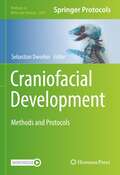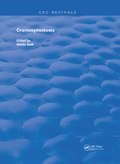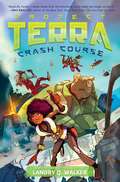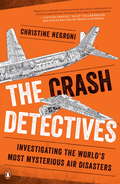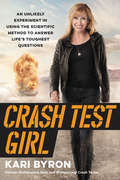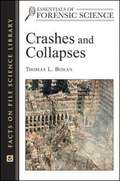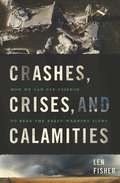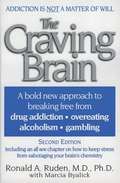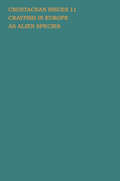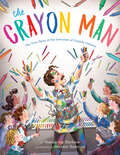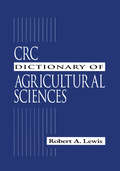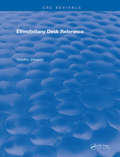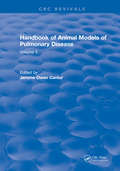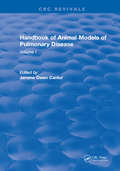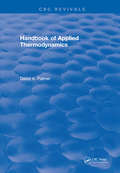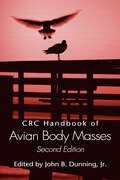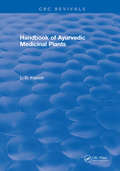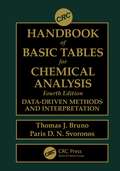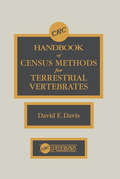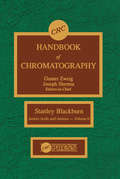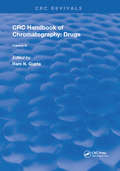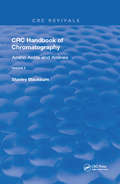- Table View
- List View
Craniofacial Development: Methods and Protocols (Methods in Molecular Biology #2403)
by Sebastian DworkinThis volume explores scientific methodologies currently employed to integrate observational developmental biology, tissue explant and cell-based approaches and genetic/molecular technologies to develop a holistic understanding of craniofacial development. Chapters guide readers through the use of disparate models to study formation of the head and face (c. elegans, zebrafish, mouse, alongside human imaging approaches), together with cell culture, tissue explant and in vivo cell imaging and analysis techniques. At the molecular level, chapters include analysing gene expression using in-situ hybridisation and single-cell RNA-Sequencing (scRNA-SEQ), as well as genetic modification techniques such as CRISPR/Cas9-mediated deletion. Written in the format of the highly successful Methods in Molecular Biology series, each chapter includes an introduction to the topic, lists necessary materials and reagents, includes tips on troubleshooting and known pitfalls, and step-by-step, readily reproducible protocols. Authoritative and cutting-edge, Craniofacial Development: Methods and Protocols aims to be a guide in the field of craniofacial development for senior and new researchers looking to expand their existing research programs to encompass novel techniques.
Craniosynostosis (Routledge Revivals)
by Guido GalliPublished in 1984, this book explores craniosynostosis, providing a synthesis of diagnostic aspects and the therapeutic orientation derived from both the evolution of pathogenetic theory, and the necessity to recognize and treat affected children as early as possible. Focusing on craniosynostosis in the first year of life the books has a practical, clinical and applicative content and will be of use to the practicing physician as well as the specialist reader.
Crap Taxidermy
by Kat SuA humorous look at what happens when taxidermy goes terribly wrong, by the founder of the hit website crappytaxidermy.com.A relaxed toad enjoying a smoke and a brew. A cat with eerily flexible front legs. A smiling lion with receding gums. Whether you choose to laugh or cringe at these spectacularly bad attempts at taxidermy, you won't be able to tear your eyes away from the curiosities inside. This volume brings together the very best of the worst (along with a DIY "Stuff Your Own Mouse" lesson by an Insect Preparator from the American Museum of Natural History), showcasing the most perverse yet imaginative anatomical reconstructions of the animal kingdom you'll ever see.From the Hardcover edition.
Crash Course #1
by Landry Q. Walker Keith ZooGuardians of the Galaxy meets Minecraft in this hilarious sci-fi series for middle grade readers. TERRAFORMING 101 - Learn the basics of FARMING IN SPACE!! Open to first year students. For eleven-year-old Elara, life at the Academy of Terraforming Arts is a lot tougher—and stranger—than she expected. Her latest experiment accidentally blew up the moon. Her roommate, Clare, is a mute intergalactic sponge. And no one at her new school knows what it's like to grow up on a planet called "Nowhere." But if the greatest Planetary Designers in the galaxy made it through their first year, then so can she.Based on the real science behind terraforming, this action-packed story mixes world-building adventures with side-splitting humor, plus a dash of intergalactic madness.
The Crash Detectives: Investigating the World's Most Mysterious Air Disasters
by Christine Negroni"Negroni is a talented aviation journalist who clearly understands the critically important part the human factor plays in aviation safety." --Captain Chesley "Sully" Sullenberger, pilot of US Airways 1549, the Miracle on the HudsonOne of The Wall Street Journal's 3 Books Every Geek Should Read This FallA fascinating exploration of how humans and machines fail--leading to air disasters from Amelia Earhart to MH370--and how the lessons learned from these accidents have made flying safer. In The Crash Detectives, veteran aviation journalist and air safety investigator Christine Negroni takes us inside crash investigations from the early days of the jet age to the present, including the search for answers about what happened to the missing Malaysia Airlines Flight 370. As Negroni dissects what happened and why, she explores their common themes and, most important, what has been learned from them to make planes safer. Indeed, as Negroni shows, virtually every aspect of modern pilot training, airline operation, and airplane design has been shaped by lessons learned from disaster. Along the way, she also details some miraculous saves, when quick-thinking pilots averted catastrophe and kept hundreds of people alive. Tying in aviation science, performance psychology, and extensive interviews with pilots, engineers, human factors specialists, crash survivors, and others involved in accidents all over the world, The Crash Detectives is an alternately terrifying and inspiring book that might just cure your fear of flying, and will definitely make you a more informed passenger."Christine Negroni combines her investigative reporting skills with an understanding of the complexities of air accident investigations to bring to life some of history's most intriguing and heartbreaking cases." --Bob Woodruff, ABC News From the Trade Paperback edition.
Crash Test Girl: An Unlikely Experiment in Using the Scientific Method to Answer Life’s Toughest Questions
by Kari ByronKari Byron—former host of the wildly popular, iconic cult classic MythBusters—shows how to crash test your way through life, no lab coat required. Kari Byron’s story hasn’t been a straight line. She started out as a broke artist living in San Francisco, writing poems on a crowded bus on the way to one of her three jobs. Many curve balls, unexpected twists, and yes, literal and figurative explosions later, and she’s one of the world’s most respected women in science entertainment, blowing stuff up on national television and getting paid for it! In Crash Test Girl, Kari reveals her fascinating life story on the set of MythBusters and beyond. With her signature gusto and roll-up-your-sleeves enthusiasm, she invites readers behind the duct tape and the dynamite, to the unlikely friendships and low-budget sets that turned a crazy idea into a famously inventive show with a rabid fanbase. The truth is, Mythbusters was never meant to be a science show. But attaching a rocket to a car, riding a motorcycle on water, or lighting 500 pounds of coffee creamer on fire requires a decent understanding of chemistry, physics, and engineering. Thus, the cast and crew brought in the scientific method to work through each problem: Question. Hypothesize. Experiment. Analyze. Conclude. And as Kari came to learn in her own life, not only is the scientific method the best approach for busting myths, it’s also the perfect tool for solving everyday issues, including:Career · Love · Creativity · Setbacks · Money · Sexuality · Depression · BraveryCrash Test Girl reminds us that science is for everyone, as long as you’re willing to strap in, put on your safety goggles, hit a few walls, and learn from the results. Using a combination of methodical experimentation and unconventional creativity, you’ll come to the most important conclusion of all: In life, sometimes you crash and burn, but you can always crash and learn.
Crashes and Collapses
by Thomas L. BohanCrashes and Collapses includes a collection of stories based on real cases involving the forensic engineering sciences. It may surprise those whose view of forensic science has been formed by those television shows to learn that a large fraction, perhaps most, of forensic work involves the engineering sciences and that this has been the case since ancient times. This book is about some of that work and is aimed at introducing curious adults as well as middle- and high-school students to the world of forensic science in such a way that they will be better able to evaluate what they hear and see about forensic investigations and also about the broader world within which these investigations take place.
Crashes, Crises, and Calamities: How We Can Use Science to Read the Early-Warning Signs
by Len FisherWhy do certain civilizations, societies, and ecosystems collapse? How does the domino effect relate to the credit crunch? When can mathematics help explain marriage? And how on earth do toads predict earthquakes? The future is uncertain. But science can help foretell what lies ahead. Drawing on ecology and biology, math and physics, Crashes, Crises, and Calamities offers four fundamental tools that scientists and engineers use to forecast the likelihood of sudden change: stability, catastrophe, complexity, and game theories. In accessible prose, Len Fisher demonstrates how we can foresee and manage events that might otherwise catch us by surprise. At the cutting edge of science, Fisher helps us find ways to act before a full-fledged catastrophe is upon us. Crashes, Crises, and Calamities is a witty and informative exploration of the chaos, complexity, and patterns of our daily lives.
The Craving Brain: A Bold New Appraoch to Breaking Free from Drug Addiction, Overeating, Alcoholism, Gambling (Second Edition)
by Marcia Byalick Ronald A. RudenIn the Craving Brain, Dr. Ronald Ruden asserts that the roots of addiction most definitely do not lie in our character. Rather, they lie in a complex chain reaction that originates in an ancient survival mechanism in the brain. When this system is inappropriately activated, it drives the body to crave, sometimes with addictive behavior as the end result. In clear, straightforward language, Dr. Ruden outlines his remarkable successful treatment program which he believes can cure this problem. The Craving Brain offers crucial insights into the world of addiction. This revolutionary book will bring hope to millions of people who suffer from a wide range of addictions, from gambling and alcohol to drugs and food.
Crayfish in Europe as Alien Species (Advances In Crustacean Research Ser. #Vol. 11)
by Francesca Gherardi David M. HoldichFrom the third international workshop on the subject (U. of Florence, 1997), come 18 papers reviewing the issue of alien crayfish decimating the relatively few native species in European freshwater environments. In a historical and taxonomic context, the initial paper explains why such homogenizatio
The Crayon Man: The True Story of the Invention of Crayola Crayons
by Natascha BiebowCelebrating the inventor of the Crayola crayon! This gloriously illustrated picture book biography tells the inspiring story of Edwin Binney, the inventor of one of the world's most beloved toys. A perfect fit among favorites like The Day the Crayons Quit and Balloons Over Broadway.purple mountains&’ majesty, mauvelous, jungle green, razzmatazz… What child doesn't love to hold a crayon in their hands? But children didn't always have such magical boxes of crayons. Before Edwin Binney set out to change things, children couldn't really even draw in color. Here&’s the true story of an inventor who so loved nature&’s vibrant colors that he found a way to bring the outside world to children – in a bright green box for only a nickel! With experimentation, and a special knack for listening, Edwin Binney and his dynamic team at Crayola created one of the world&’s most enduring, best-loved childhood toys – empowering children to dream in COLOR!
Crazy Contraptions (Fountas & Pinnell LLI Purple #Level S)
by Jordan BrownFailure is fun! Or at least it can be when you're creating a Rube Goldberg Machine (RGM). These crazy homemade machines use a bunch of silly steps and chain reactions to accomplish a simple task. Learn the secrets of how to make your own.
CRC Dictionary of Agricultural Sciences
by Robert Alan LewisThis dictionary includes every area of agriculture, from traditional farming to the latest techniques in biotechnology and genetics. The dictionary provides standardized definitions that establish common ground between the various types of practitioners involved in agriculture. It defines terminology in areas such as agricultural economics and business, agroecology, agronomy, animal science, aquaculture, botany, conservation, dairy science, entomology, food science, forestry, horticulture, natural resource management, and much more.
CRC Ethnobotany Desk Reference
by Tim JohnsonThe CRC Ethnobotany Desk Reference contains almost 30,000 concise ethnobotanical monographs of plant species characteristics and an inventory of claimed attributes and historical uses by cultures throughout the world-the most ambitious attempt to date to inventory plants on a global scale and match botanical information with historical and current uses.To obtain the same information about any species listed, you would have to thumb through hundreds of herbal guides, ethnobotanical manuals, and regional field guides. Sources for this index include the three largest U.S. Government ethnobotany databases, the U.S. National Park Service NPFlora plant inventory lists, and 18 leading works on the subject.
CRC Handbook of Animal Models of Pulmonary Disease: Volume II
by Jerome Owen CantorThis two-volume handbook provides important information concerning the development, implementation, evaluation, uses, advantages, and limitations of a wide variety of animal model of pulmonary disease. While the work focuses on stepwise procedures for inducing and quantifying disease, additional emphasis is placed on each model's relationship to human counterparts and on comparisons with similar models of injury. Thus, even the novice researcher will be able to more sharply define a particular research question, find suitable animal models for study, gain access to specialized techniques, and evaluate results within the context of an up-to-date body of information about related forms of lung diseases.
CRC Handbook of Animal Models of Pulmonary Disease: Volume I
by Jerome Owen CantorThis two-volume handbook provides important information concerning the development, implementation, evaluation, uses, advantages, and limitations of a wide variety of animal model of pulmonary disease. While the work focuses on stepwise procedures for inducing and quantifying disease, additional emphasis is placed on each model's relationship to human counterparts and on comparisons with similar models of injury. Thus, even the novice researcher will be able to more sharply define a particular research question, find suitable animal models for study, gain access to specialized techniques, and evaluate results within the context of an up-to-date body of information about related forms of lung diseases.
CRC Handbook of Applied Thermodynamics
by David A. PalmerThis practical handbook features an overview of the importance of physical properties and thermodynamics; and the use of thermo-dynamics to predict the extent of reaction in proposed new chem-ical combinations. The use of special types of data and pre-diction methods to develop flowsheets for probing projects; and sources of critically evaluated data, dividing the published works into three categories depending on quality are given. Methods of doing one's own critical evaluation of literature, a list of known North American contract experimentalists with the types of data mea-sured by each, methods for measuring equilibrium data, and ther-modynamic concepts to carry out process opti-mization are also featured.
CRC Handbook of Avian Body Masses
by John B. Dunning Jr.See what's new in the Second Edition: Number of species included is increased from 6300 to over 8700, about 85% of the world's birds Better data for many of the species included in the first edition- an exhaustive compilation of new data publis
CRC Handbook of Ayurvedic Medicinal Plants
by L. D. KapoorThis handbook is filled with over 50 illustrations and descriptions of approximately 250 plants which are used for herbal medicine. It includes the most current information available today on medicinal plants ranging from Abies spectabilis to Zizyphus vulgaris. The purpose of this handbook is to make available a reference for easy, accurate identification of these herbs. Derived from India, "Ayurveda" is the foundation stone of their ancient medical science. Approximately 80 percent of the population of India and other countries in the East continue to utilize this system of medicinal treatment. It is believed that the key to successful medication is the use of the correct herb. This is an indispensable resource for all physicians, pharmacists, drug collectors, and those interested in the healing art.
CRC Handbook of Basic Tables for Chemical Analysis: Data-Driven Methods and Interpretation
by Thomas J. Bruno Paris D.N. SvoronosResearchers in chemistry, chemical engineering, pharmaceutical science, forensics, and environmental science make routine use of chemical analysis, but the information these researchers need is often scattered in different sources and difficult to access. The CRC Handbook of Basic Tables for Chemical Analysis: Data-Driven Methods and Interpretation, Fourth Edition is a one-stop reference that presents updated data in a handy format specifically designed for use when reaching a decision point in designing an analysis or interpreting results. This new edition offers expanded coverage of calibration and uncertainty, and continues to include the critical information scientists rely on to perform accurate analysis. Enhancements to the Fourth Edition: Compiles a huge array of useful and important data into a single, convenient source Explanatory text provides context for data and guidelines on applications Coalesces information from several different fields Provides information on the most useful "wet" chemistry methods as well as instrumental techniques, with an expanded discussion of laboratory safety Contains information of historical importance necessary to interpret the literature and understand current methodology. Unmatched in its coverage of the range of information scientists need in the lab, this resource will be referred to again and again by practitioners who need quick, easy access to the data that forms the basis for experimentation and analysis.
CRC Handbook of Census Methods for Terrestrial Vertebrates
by David E DavisLearn how to start a census program for terrestrial vertebrates with this handbook. Whether the information you need is for managing a population, surveying environmental impact, or conducting research on a particular species, this handbook has it all. Principles, methods, and calculations are explained. The following information is given for each species: name; range; reasons for census; life history; items of importance, e.g., migration; methods of census; recent and pertinent references; and comments about the various methods.
CRC Handbook of Chromatography: Amino Acids and Amines, Volume II
by S. BlackburnAn in-depth analysis of chromatography literature and procedures since 1981 is presented in this publication. Featured is a compre-hensive range of tables relating to the chromatographic separation and determination of amino acids, amines, and their derivatives. Methods of sample preparation and derivatization and methods of detection are described. Included are techniques for the liquid and gas chro-matographic separation of free amino acids and their derivatives, including o-phthalaldehyde, dansyl, and phenylthiolaydantoin deriva-tives. The separation of amino acid enantiomers is also described. This book will be invaluable to chemists, biochemists, and analysts involved in the separation and determination of amino acids or amines and their derivatives.
CRC Handbook of Chromatography: Drugs, Volume III (Handbook Of Chromatography Ser. #2)
by Ram N. GuptaThese volumes provide a reference source of different gas chro-matographic, liquid chromatographic, or thin-layer chromatographic techniques for the qualitative determination of various therapeutic agents, including antibiotics, vitamins and hormones, drugs of abuse in body fluids, dosage forms, or food stuffs. Over 5000 publi-cations were reviewed to prepare tables of chromatographic data for 800 compounds, arranged alphabetically by generic drug name or by drug groups. A detailed summary of the extraction procedure de-scribed in each publication included in the table of a particular drug is also provided. This easy-to-read handbook is useful for se-lecting an appropriate chromatographic procedure for the determi-nation of a given compound according to the available facilities.
CRC Handbook of Chromatography: Amino Acids and Amines, Volume II
by Ram N. GuptaThese volumes provide a reference source of different gas chro-matographic, liquid chromatographic, or thin-layer chromatographic techniques for the qualitative determination of various therapeutic agents, including antibiotics, vitamins and hormones, drugs of abuse in body fluids, dosage forms, or food stuffs. Over 5000 publi-cations were reviewed to prepare tables of chromatographic data for 800 compounds, arranged alphabetically by generic drug name or by drug groups. A detailed summary of the extraction procedure de-scribed in each publication included in the table of a particular drug is also provided. This easy-to-read handbook is useful for se-lecting an appropriate chromatographic procedure for the determi-nation of a given compound according to the available facilities.

